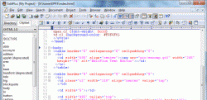Index >> Development >> Other >> URL Escaped Encoding Decoder
Report SpywareURL Escaped Encoding Decoder 1.0
Software Description:
URL Escaped Encoding Decoder - It is used to decode the Escaped-encoding URL.
It is used to decode the Escaped-encoding URL.
Escaped-encoding, or sometimes referred to as percent-encoding, is the standard of representing characters within a URI that may need special syntax handling to be correctly interpreted. It uses a sequence of three characters to encode the character to be interpreted. This triplet sequence consists of the percentage character “%” followed by the two hexadecimal digits representing the octet code of the original character. For example, the US-ASCII character set represents a space with octet code 32, or hexadecimal 20. Thus its URL-encoded representation is %20.
Applications may automatically escape reserved and unreserved characters, or automatically un-escape an escape-encoded sequence within a URI, if there is potential for it to be incorrectly interpreted by the remote application. This conversion may be due to the position of the character or escape-encoded sequence within the URI. For example, "%7e" is sometimes used instead of "~" in an http URL path, but the two are equivalent for an http URL.
Because the percent "%" character always has the reserved purpose of being the escape indicator, it must be escaped as "%25" in order to be used as data within a URI. The RFC for URI encoding recommends that care should be taken not to escape or un-escape the same string more than once, since un-escaping an already un-escaped string might lead to misinterpreting a percent data character as another escaped character, or vice versa in the case of escaping an already escaped string.
Useful Character Escape Code:
SPACE %20
< %3C
> %3E
# %23
% %25
{ %7B
} %7D
| %7C
\ %5C
^ %5E
~ %7E
[ %5B
] %5D
` %60
; %3B
/ %2F
? %3F
: %3A
@ %40
= %3D
& %26
$ %24
It is used to decode the Escaped-encoding URL.
Escaped-encoding, or sometimes referred to as percent-encoding, is the standard of representing characters within a URI that may need special syntax handling to be correctly interpreted. It uses a sequence of three characters to encode the character to be interpreted. This triplet sequence consists of the percentage character “%” followed by the two hexadecimal digits representing the octet code of the original character. For example, the US-ASCII character set represents a space with octet code 32, or hexadecimal 20. Thus its URL-encoded representation is %20.
Applications may automatically escape reserved and unreserved characters, or automatically un-escape an escape-encoded sequence within a URI, if there is potential for it to be incorrectly interpreted by the remote application. This conversion may be due to the position of the character or escape-encoded sequence within the URI. For example, "%7e" is sometimes used instead of "~" in an http URL path, but the two are equivalent for an http URL.
Because the percent "%" character always has the reserved purpose of being the escape indicator, it must be escaped as "%25" in order to be used as data within a URI. The RFC for URI encoding recommends that care should be taken not to escape or un-escape the same string more than once, since un-escaping an already un-escaped string might lead to misinterpreting a percent data character as another escaped character, or vice versa in the case of escaping an already escaped string.
Useful Character Escape Code:
SPACE %20
< %3C
> %3E
# %23
% %25
{ %7B
} %7D
| %7C
\ %5C
^ %5E
~ %7E
[ %5B
] %5D
` %60
; %3B
/ %2F
? %3F
: %3A
@ %40
= %3D
& %26
$ %24
100% Clean:
 URL Escaped Encoding Decoder 1.0 is 100% clean
URL Escaped Encoding Decoder 1.0 is 100% cleanThis download (escenc.zip) was tested thoroughly and was found 100% clean. Click "Report Spyware" link on the top if you found this software contains any form of malware, including but not limited to: spyware, viruses, trojans and backdoors.
Related Software:
- Database Architect 2.0 - Define database tables, fields, references, and generate the database
- Binary Browser 6.1 - Programmer file format, structure, search, history and comparison tools
- Transaction 1.6.9 - Online sales interactive data analysis and reporting tool
- CoffeeCup Sitemapper 6.0.341 - Create snazzy sitemaps in seconds!
- Quick Batch File Compiler 3.6.1.0 - Quick Batch File compiler convert batch files into actual program in one click
- FastScript 1.101 - Cross-platform multi-language (VB, JS, Pascal and C++) scripting engine
- Practiline Source Code Line Counter 1.0 - Source code line count software for developers and project managers
- pgISQL (Interactive SQL for PostgreSQL) 2.2.0 - Windows GUI database administrator tool for PostgreSQL
- FlexHEX 2.6 - Advanced hex editor. Can edit files, logical, and physical drives.
- EzALV - generates ALV program using the Standard SAP Function Modules.
top 10 most downloaded
recommended software
-
- HelpSmith
- HelpSmith is an innovative help authoring tool which allows you to create CHM Help files, Web Help , Word RTF, and Manuals from a single source. The r...

-
- EditPlus
- EditPlus is a text editor, HTML editor, PHP editor and Java editor for Windows. While it can serve as a good Notepad replacement, it also offers many ...


